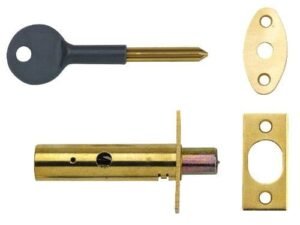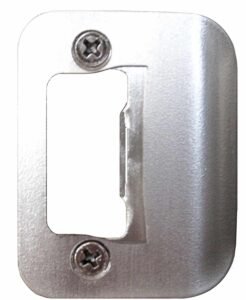Door locks are critical. They offer more safety and security than any other appliance or tool. They serve as a barrier to keep your building facility and workspace safe and private. When looking for locks for your facility, efficiency is critical to operate efficiently.
The sheer number of different kinds of door locks can be attributed to the necessity of different levels of security and different kinds of doors that necessitate securing.
When it comes to door security, whether you’re securing a front door, pocket door, or cabinet door, you want the best lock for the job.
Every year, approximately 2 million residences are broken into, so understanding the key differences between the types of door locks allows you to make better choices for your facility. Alternatively, if you work as a locksmith or in the lock installation industry, knowing these details will allow you to make more informed decisions for your customers. Explore our guide to learn about the five different types of door locks, their best applications, and how to install each one and another.
There are numerous reasons to install door locks in your home, one of which could protect your family, home, and belongings. However, when you go to the hardware store, you will discover various varieties of locks in different sizes, shapes, and designs. Do you have any ideas on what is the right one for your home?
This ultimate guide to door locks can help you to understand the differences between different types of locks so that you can choose the right one for your external and internal doors. You do have to admit that your office door requires a different type of lock than your front or rear door.
Parts of a Door Lock
In the event that you ever need to change the used locks on your doors, you will need to know the names of various parts, their role in the overall locking mechanism, and how they help the other parts to keep the door locked.
Although the individual parts may vary depending on the type of door lock we’ll be discussing shortly, the look and how the parts function will generally be the same. These are the standard components of door locks, and you’ll see them in almost all of the locks in the industry.
Cylinder Drill

The cylinder is the portion of the lock where the key is inserted. The key must be able to fit into the cylinder correctly, which will allow you to open the lock. Even a slightly misshapen key will prevent the cylinder from unlocking.
When you place the key in the cylinder, a number of spring-loaded pins move to expand the cylinder. In order for the pins to move as the key moves further into the cylinder, you must use the correct key. Once this is done, the electronic door locks will be able to unlock by using the bolt.
If a cylinder is damaged, you can sometimes replace it instead of having it replaced. If the full door lock mechanism will be expensive to replace, this is a good option. When you purchase a new lock, however, it is usually less expensive.
Bolt/Latch

When the key properly fits the cylinder, the pins inside the cylinder move, engaging the bolt (sometimes referred to as a latch) within the door lock. This is the moving part of the lock that moves in and out and rests in the carved-out part of the door frame, known as the box, when the door is locked, keeping it in place.
In addition to the deadbolt and spring bolt, there are two main types of bolts you’ll encounter: the mechanical and dynamic bolt.
– Dead Bolt
A deadbolt is a lock that you have to lock yourself. This is the kind of lock that will feature a cylinder that requires the correct key to open it. Spring bolts have fallen out of favor in recent years because they are considered to be less safe and more susceptible to wear and tear. Because of this, most places nowadays use deadbolts or a combination of the two.
– Spring Bolt
In addition to using spring bolts, use a small clip to ensure that the bolts stay in place. When the key moves the pins in the cylinder, the clip compresses, unlocking the bolt and enabling it to return inside the lock to open the door.
The act of closing the door causes the spring to release, which causes the bolt to move back in place to keep the door closed. Many times, the springs on the door act like a hotel-style lock when the door is closed, which is similar to the way that type of lock is set on hotel doors.
These are great options for increasing security for people who may forget to lock the door behind them.
Strike Plate

The strike plate is where the lock is attached to the door frame to keep the door in position when you lock it. This part is a simple, heavy-duty metal part that screws to the door frame and is the most straightforward of the lock’s components to replace in the event that it gets damaged.
The box is the part of the door frame where the bolt locks in place. In most cases, the box is a small, squarish hole that is sized to accommodate the bolt. The majority of bolts are of a similar size, meaning that the box is approximately the same size that can fit most of the locks in the home.
Type of Door Locks – Answer the Questions
To best serve the needs of different users, it is a good idea to employ different kinds of door locks. Outdoor-entry locks are a better choice when you’re leaving your house, as they provide more security against burglars attempting to gain access to your home.
Other locks are also suitable for keeping doors within your home secure, like those in the bathroom and the closet. They provide just enough security to keep others out, but they are lacking in the level of security necessary for outside doors.
The way to think about this is that some locks are designed to be locked from the outside of the door, others are only for use when locked from the inside of the door, and yet others are accessible from both the outside and inside of the door.e
Knob Locks
-
- Door Knob locks are the most common type of door lock and the primary means of security for the majority of bedroom doors. Instead of the door, the lock cylinder is located in the knob. As a result, knob locks should not be used on external doors because they can be broken into with simple tools such as a hammer or wrench.
Handleset Locks
There are two locking mechanisms: a handle with either a keyed or twist knob on the external side, or a locking system that incorporates a handle with a twist knob on the internal side. The deadbolt featured in this type of lock provides extra security because it does not have a spring bolt. These doorknob locks provide the same function as a doorknob lock, but offer a more attractive look for the exterior of a home.
Hand Levers
Handles are a great choice for closets, like coat closets, or basement doors because of their durability and control. The levers on both sides of the grinder feature a handle that can be gripped with one hand and rotated with the other.
In terms of security, these locks provide less protection than other locks, and as such, they are not a good choice for doors used for entry. While there is some benefit to having the ability to open doors quickly with one hand, they still allow you to do so. This comes in handy when you are moving groceries or laundry throughout the home.
Cam Lock
-
- Cam locks are a type of fastener that allows storage to be kept intact while remaining undetectable to the naked eye. They are mostly undetectable in fully assembled cabinets. Cam locks are typically included with furniture and cabinet kits. These door locks are cylindrical in shape and are installed in the wooden portion of the door. A metal tube with a hole on one side aids in the positioning of the inserted bolt. Certain cam locks completely secure cabinet doors, making them appealing measures for storing sensitive materials. Cam locks create a locking mechanism by combining various tailpieces or “cams.”
Deadbolts Locks
-
- Deadbolts provide the most security against a burglary or break-in. Without the use of a spring, lock bolts are moved by turning a knob or key. Deadbolts have a one-of-a-kind locking mechanism that is resistant to physical attacks, battering, and boring. They are not openable with a knife or a hand tool. There are three types of deadbolt locks: single, double, and C.
- Single cylinder deadbolts are the most basic and can only be opened from one side with a key. A key from both sides can be used to open a double cylinder deadbolt. A single, double, or lockable thumb turn deadbolt has an internal thumb turn that can be locked with a key. This type of deadbolt offers the most versatility and security.
Padlocks
-
- Padlocks are a type of free-standing lock. They are portable, which means that, unlike other types of locks, they are not permanently attached to a door or anything that uses them. Padlocks are available in a variety of styles, which are divided into two categories: keyed and combination. Keyed padlocks come in a variety of subtypes, including keyed alike, keyed different, and keyable. Padlocks are easy to identify not only because they are mobile, but also because of their looped-handle shackle shape. They have a shouldered shackle, which is a feature in which the padlock shoulders raise the sides of the shackle to prevent bolt cutters from cutting through it.
Mortise Locks
-
- Mortise locks are strong locks that are commonly found on exterior doors. They are, however, available in both light and heavy duty models. They have an internal system, so they are more like locksets than just locks. These locksets, which frequently have a cylindrical body, can house either knobs or levers. They are threaded and use mortise components that are built into the door. A box lock is installed within the mortise, which is a deep recess in the door’s edge. Mortise locksets are secure because they use a set screw and a cam to create the locking mechanism. For various types of doors, the cylinder component is available in a variety of heights and lengths.


No Comments
Be the first to start a conversation